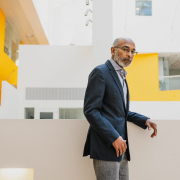By unlocking the secrets of anesthesia, Professor Emery Brown could help shed light on brain diseases, hibernation, and possibly even human consciousness.
By Adam Piore
Last spring, Brown stepped down after 10 years as co-director of the Harvard-MIT Program in Health Sciences and Technology (HST), which trains clinician-scientists and engineers, to focus on creating a new joint research center between MIT and MGH. The center will use anesthesia to reveal new insights into a wide array of seemingly unrelated brain diseases, potentially aiding in the development of treatments. Among other things, he hopes to shed new light on depression, insomnia, epilepsy, and Alzheimer’s disease and explore the possibility of human hibernation for medically induced comas or space travel. He and his colleagues at the center may even help unravel the mystery of consciousness itself.
Brown, who began a sabbatical in January, is now preparing for a late-spring launch of the new center, which will begin with existing collaborators but may eventually expand to include new hires.
Anesthesia, he has demonstrated, works largely by modulating the delicate biochemistry of different regions of the brain in ways that disrupt how they normally communicate with each other—allowing anesthesiologists to effectively turn down, even mute, the volume of incoming or outgoing brain signals (like signals from nerve cells that would normally cause feelings of intense pain). He and his colleagues have spent more than a decade characterizing how different types of anesthesia—including propofol, sevoflurane, ketamine, dexmedetomidine, and opioids—affect different areas of the brain. This led to studies like one that found a way to administer anesthesia that could minimize the need for post-surgical opioids. And now they plan to apply some of the non-opioid anesthetics as experimental tools to modulate the volume of different signals across the brain and manipulate various brain states in ways that could reveal new insights.
Anesthesia, it turns out, is good for more than just helping patients get through surgery. These potent compounds are also powerful neuroscience research tools.
“We’re in a position to really study a lot of different phenomena,” he says. “Because we’re thinking about anesthesia as a neuroscience phenomenon, we can talk in an informed way about sleep, about depression, about Alzheimer’s, about coma recovery, about hibernation. Now that we’ve come to understand how these drugs act in the brain, we can postulate ideas about what’s being turned on, what’s being turned off in these brain states. And we can study this in a precise way.”
The opening of the center, for which Brown is still actively fundraising, comes amidst a season of triumph for the veteran MIT professor. (In addition to his multiple appointments at MIT—where he’s the Edward Hood Taplin Professor of Medical Engineering, a professor of computational neuroscience, a professor of health sciences and technology, an investigator at the Picower Institute for Learning and Memory, and a core faculty member at the Institute for Medical Engineering and Science—he’s also the Warren M. Zapol Professor of Anesthesia at Harvard Medical School and an anesthesiologist at Massachusetts General Hospital.) This fall, Brown was awarded the prestigious Gruber Neuroscience Prize, which comes with a $500,000 grant he split with three other scientists. He recently received a write-up in the New York Times for a paper that highlights similarities between the brain states of anesthetized covid patients and hibernating turtles. And once animal testing is successfully completed, he plans to apply for FDA approval to begin human trials for what he calls a closed-loop anesthesia delivery system—an autopilot technique of sorts. Based on an AI algorithm he developed, the system would measure the correct anesthesia dosage and update it second by second, in response to minute changes in brain waves, to precisely maintain a specified level of unconsciousness...
Read the full story on the MIT Technology Review website using the link below.

